Financial Accounting: Framework, Theories, and Revaluation Report
VerifiedAdded on 2021/05/31
|9
|2494
|294
Report
AI Summary
This comprehensive financial accounting report delves into key aspects of financial reporting and analysis. It begins by examining the revised framework issued by the Financial Accounting Standards Board (FASB) and the International Accounting Standards Board (IASB), focusing on the qualitative characteristics of financial information, including relevance, faithful representation, comparability, timeliness, verifiability, and understandability. The report then explores economic interest group theory, capture theory, and public interest theory, analyzing their implications for regulation and corporate financial reporting. Finally, the report discusses the FASB's efforts related to impairment costs and the revaluation model for non-current assets, including factors influencing its adoption and its effects on financial statements and shareholders. The report concludes by highlighting the significance of the revaluation model and its impact on shareholder returns and asset valuation.

Financial Accounting 1
FINANCIAL ACCOUNTING
By (Student’s Name)
Professor’s Name
College
Course
Date
FINANCIAL ACCOUNTING
By (Student’s Name)
Professor’s Name
College
Course
Date
Paraphrase This Document
Need a fresh take? Get an instant paraphrase of this document with our AI Paraphraser
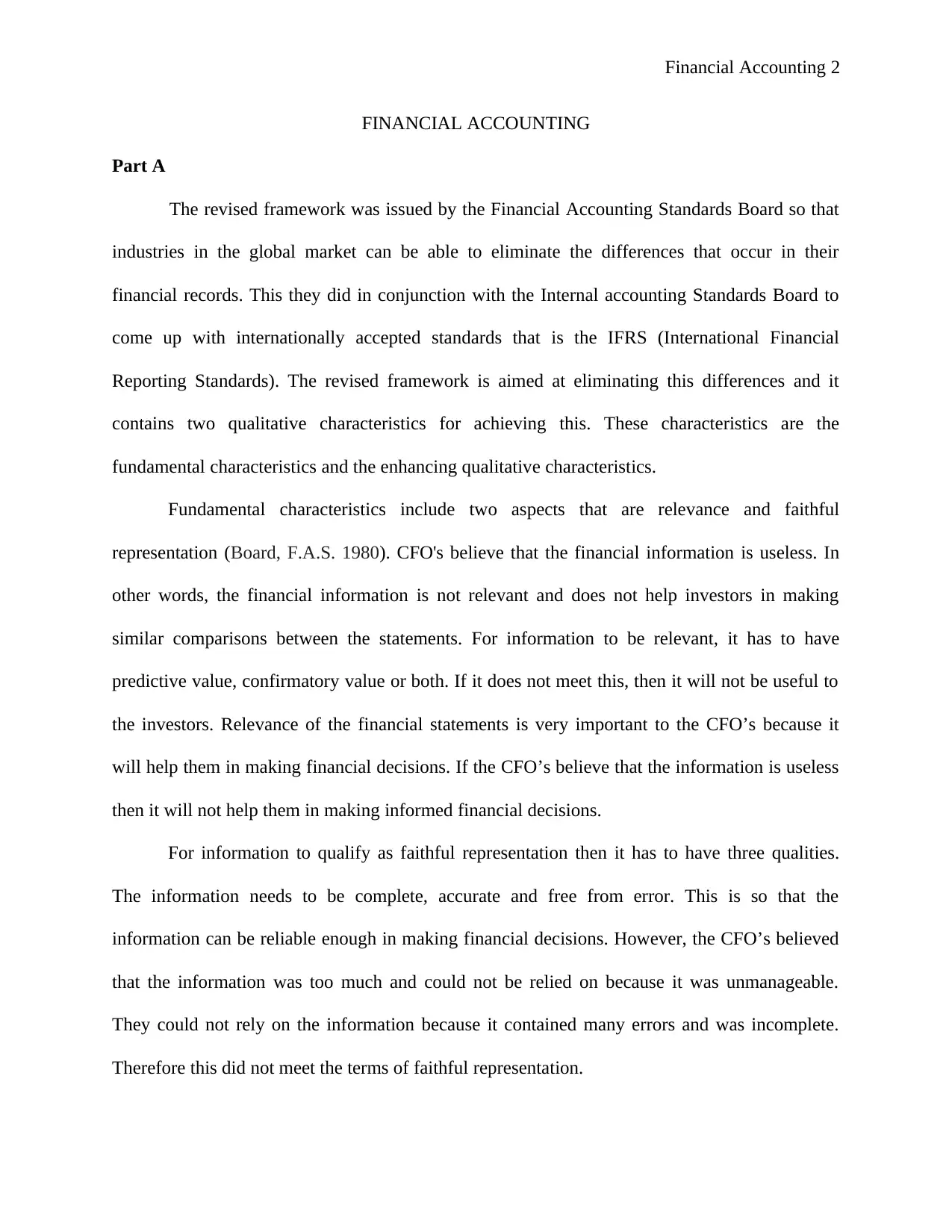
Financial Accounting 2
FINANCIAL ACCOUNTING
Part A
The revised framework was issued by the Financial Accounting Standards Board so that
industries in the global market can be able to eliminate the differences that occur in their
financial records. This they did in conjunction with the Internal accounting Standards Board to
come up with internationally accepted standards that is the IFRS (International Financial
Reporting Standards). The revised framework is aimed at eliminating this differences and it
contains two qualitative characteristics for achieving this. These characteristics are the
fundamental characteristics and the enhancing qualitative characteristics.
Fundamental characteristics include two aspects that are relevance and faithful
representation (Board, F.A.S. 1980). CFO's believe that the financial information is useless. In
other words, the financial information is not relevant and does not help investors in making
similar comparisons between the statements. For information to be relevant, it has to have
predictive value, confirmatory value or both. If it does not meet this, then it will not be useful to
the investors. Relevance of the financial statements is very important to the CFO’s because it
will help them in making financial decisions. If the CFO’s believe that the information is useless
then it will not help them in making informed financial decisions.
For information to qualify as faithful representation then it has to have three qualities.
The information needs to be complete, accurate and free from error. This is so that the
information can be reliable enough in making financial decisions. However, the CFO’s believed
that the information was too much and could not be relied on because it was unmanageable.
They could not rely on the information because it contained many errors and was incomplete.
Therefore this did not meet the terms of faithful representation.
FINANCIAL ACCOUNTING
Part A
The revised framework was issued by the Financial Accounting Standards Board so that
industries in the global market can be able to eliminate the differences that occur in their
financial records. This they did in conjunction with the Internal accounting Standards Board to
come up with internationally accepted standards that is the IFRS (International Financial
Reporting Standards). The revised framework is aimed at eliminating this differences and it
contains two qualitative characteristics for achieving this. These characteristics are the
fundamental characteristics and the enhancing qualitative characteristics.
Fundamental characteristics include two aspects that are relevance and faithful
representation (Board, F.A.S. 1980). CFO's believe that the financial information is useless. In
other words, the financial information is not relevant and does not help investors in making
similar comparisons between the statements. For information to be relevant, it has to have
predictive value, confirmatory value or both. If it does not meet this, then it will not be useful to
the investors. Relevance of the financial statements is very important to the CFO’s because it
will help them in making financial decisions. If the CFO’s believe that the information is useless
then it will not help them in making informed financial decisions.
For information to qualify as faithful representation then it has to have three qualities.
The information needs to be complete, accurate and free from error. This is so that the
information can be reliable enough in making financial decisions. However, the CFO’s believed
that the information was too much and could not be relied on because it was unmanageable.
They could not rely on the information because it contained many errors and was incomplete.
Therefore this did not meet the terms of faithful representation.
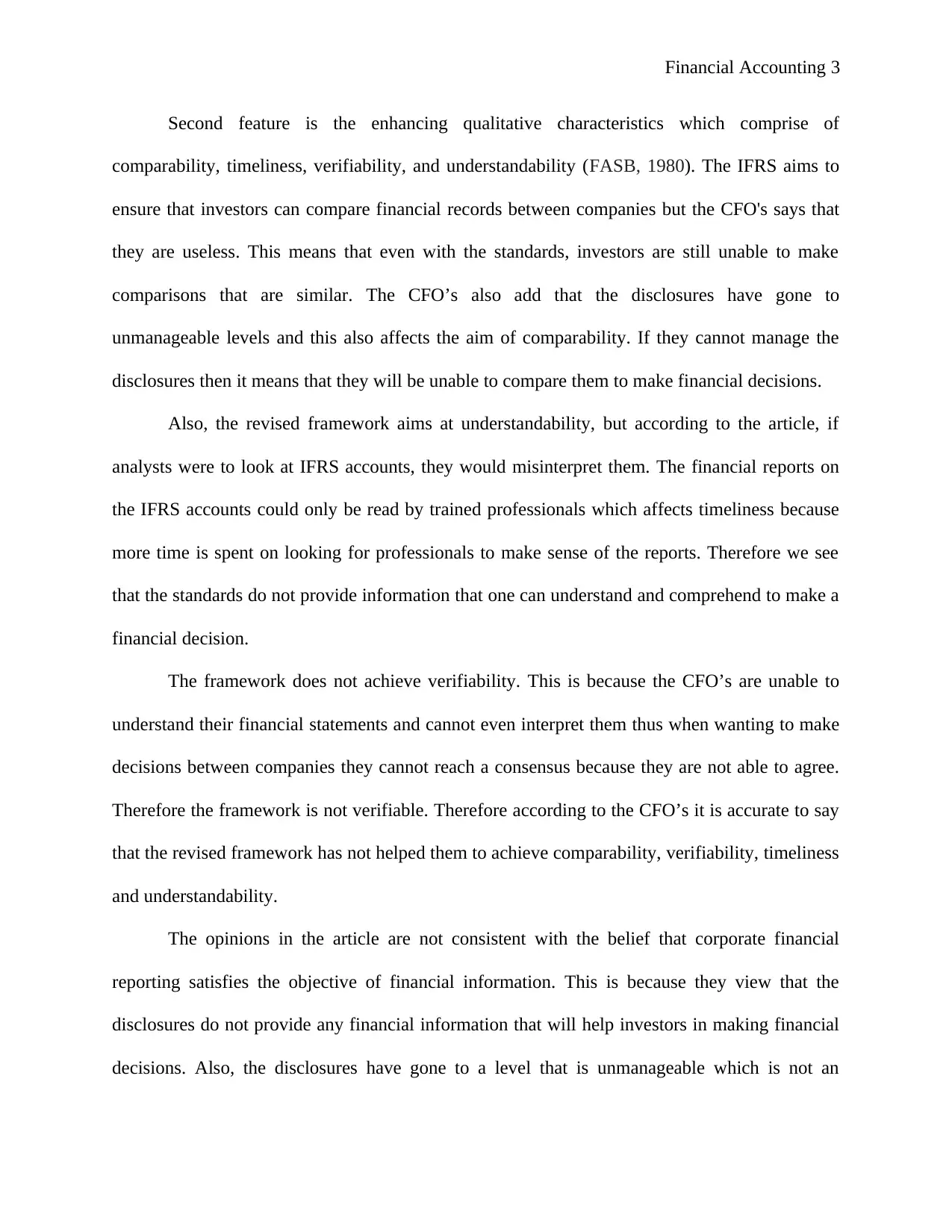
Financial Accounting 3
Second feature is the enhancing qualitative characteristics which comprise of
comparability, timeliness, verifiability, and understandability (FASB, 1980). The IFRS aims to
ensure that investors can compare financial records between companies but the CFO's says that
they are useless. This means that even with the standards, investors are still unable to make
comparisons that are similar. The CFO’s also add that the disclosures have gone to
unmanageable levels and this also affects the aim of comparability. If they cannot manage the
disclosures then it means that they will be unable to compare them to make financial decisions.
Also, the revised framework aims at understandability, but according to the article, if
analysts were to look at IFRS accounts, they would misinterpret them. The financial reports on
the IFRS accounts could only be read by trained professionals which affects timeliness because
more time is spent on looking for professionals to make sense of the reports. Therefore we see
that the standards do not provide information that one can understand and comprehend to make a
financial decision.
The framework does not achieve verifiability. This is because the CFO’s are unable to
understand their financial statements and cannot even interpret them thus when wanting to make
decisions between companies they cannot reach a consensus because they are not able to agree.
Therefore the framework is not verifiable. Therefore according to the CFO’s it is accurate to say
that the revised framework has not helped them to achieve comparability, verifiability, timeliness
and understandability.
The opinions in the article are not consistent with the belief that corporate financial
reporting satisfies the objective of financial information. This is because they view that the
disclosures do not provide any financial information that will help investors in making financial
decisions. Also, the disclosures have gone to a level that is unmanageable which is not an
Second feature is the enhancing qualitative characteristics which comprise of
comparability, timeliness, verifiability, and understandability (FASB, 1980). The IFRS aims to
ensure that investors can compare financial records between companies but the CFO's says that
they are useless. This means that even with the standards, investors are still unable to make
comparisons that are similar. The CFO’s also add that the disclosures have gone to
unmanageable levels and this also affects the aim of comparability. If they cannot manage the
disclosures then it means that they will be unable to compare them to make financial decisions.
Also, the revised framework aims at understandability, but according to the article, if
analysts were to look at IFRS accounts, they would misinterpret them. The financial reports on
the IFRS accounts could only be read by trained professionals which affects timeliness because
more time is spent on looking for professionals to make sense of the reports. Therefore we see
that the standards do not provide information that one can understand and comprehend to make a
financial decision.
The framework does not achieve verifiability. This is because the CFO’s are unable to
understand their financial statements and cannot even interpret them thus when wanting to make
decisions between companies they cannot reach a consensus because they are not able to agree.
Therefore the framework is not verifiable. Therefore according to the CFO’s it is accurate to say
that the revised framework has not helped them to achieve comparability, verifiability, timeliness
and understandability.
The opinions in the article are not consistent with the belief that corporate financial
reporting satisfies the objective of financial information. This is because they view that the
disclosures do not provide any financial information that will help investors in making financial
decisions. Also, the disclosures have gone to a level that is unmanageable which is not an
⊘ This is a preview!⊘
Do you want full access?
Subscribe today to unlock all pages.

Trusted by 1+ million students worldwide
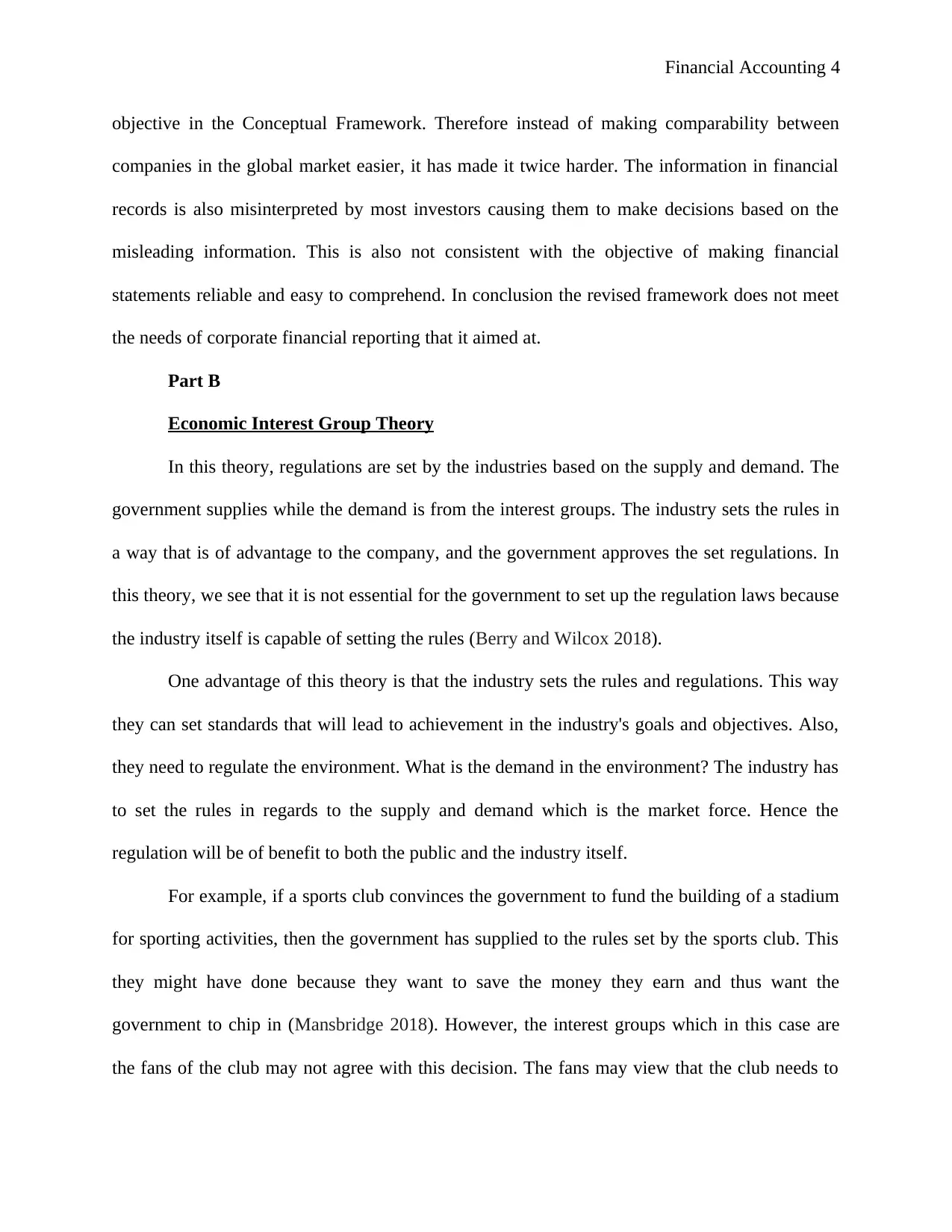
Financial Accounting 4
objective in the Conceptual Framework. Therefore instead of making comparability between
companies in the global market easier, it has made it twice harder. The information in financial
records is also misinterpreted by most investors causing them to make decisions based on the
misleading information. This is also not consistent with the objective of making financial
statements reliable and easy to comprehend. In conclusion the revised framework does not meet
the needs of corporate financial reporting that it aimed at.
Part B
Economic Interest Group Theory
In this theory, regulations are set by the industries based on the supply and demand. The
government supplies while the demand is from the interest groups. The industry sets the rules in
a way that is of advantage to the company, and the government approves the set regulations. In
this theory, we see that it is not essential for the government to set up the regulation laws because
the industry itself is capable of setting the rules (Berry and Wilcox 2018).
One advantage of this theory is that the industry sets the rules and regulations. This way
they can set standards that will lead to achievement in the industry's goals and objectives. Also,
they need to regulate the environment. What is the demand in the environment? The industry has
to set the rules in regards to the supply and demand which is the market force. Hence the
regulation will be of benefit to both the public and the industry itself.
For example, if a sports club convinces the government to fund the building of a stadium
for sporting activities, then the government has supplied to the rules set by the sports club. This
they might have done because they want to save the money they earn and thus want the
government to chip in (Mansbridge 2018). However, the interest groups which in this case are
the fans of the club may not agree with this decision. The fans may view that the club needs to
objective in the Conceptual Framework. Therefore instead of making comparability between
companies in the global market easier, it has made it twice harder. The information in financial
records is also misinterpreted by most investors causing them to make decisions based on the
misleading information. This is also not consistent with the objective of making financial
statements reliable and easy to comprehend. In conclusion the revised framework does not meet
the needs of corporate financial reporting that it aimed at.
Part B
Economic Interest Group Theory
In this theory, regulations are set by the industries based on the supply and demand. The
government supplies while the demand is from the interest groups. The industry sets the rules in
a way that is of advantage to the company, and the government approves the set regulations. In
this theory, we see that it is not essential for the government to set up the regulation laws because
the industry itself is capable of setting the rules (Berry and Wilcox 2018).
One advantage of this theory is that the industry sets the rules and regulations. This way
they can set standards that will lead to achievement in the industry's goals and objectives. Also,
they need to regulate the environment. What is the demand in the environment? The industry has
to set the rules in regards to the supply and demand which is the market force. Hence the
regulation will be of benefit to both the public and the industry itself.
For example, if a sports club convinces the government to fund the building of a stadium
for sporting activities, then the government has supplied to the rules set by the sports club. This
they might have done because they want to save the money they earn and thus want the
government to chip in (Mansbridge 2018). However, the interest groups which in this case are
the fans of the club may not agree with this decision. The fans may view that the club needs to
Paraphrase This Document
Need a fresh take? Get an instant paraphrase of this document with our AI Paraphraser
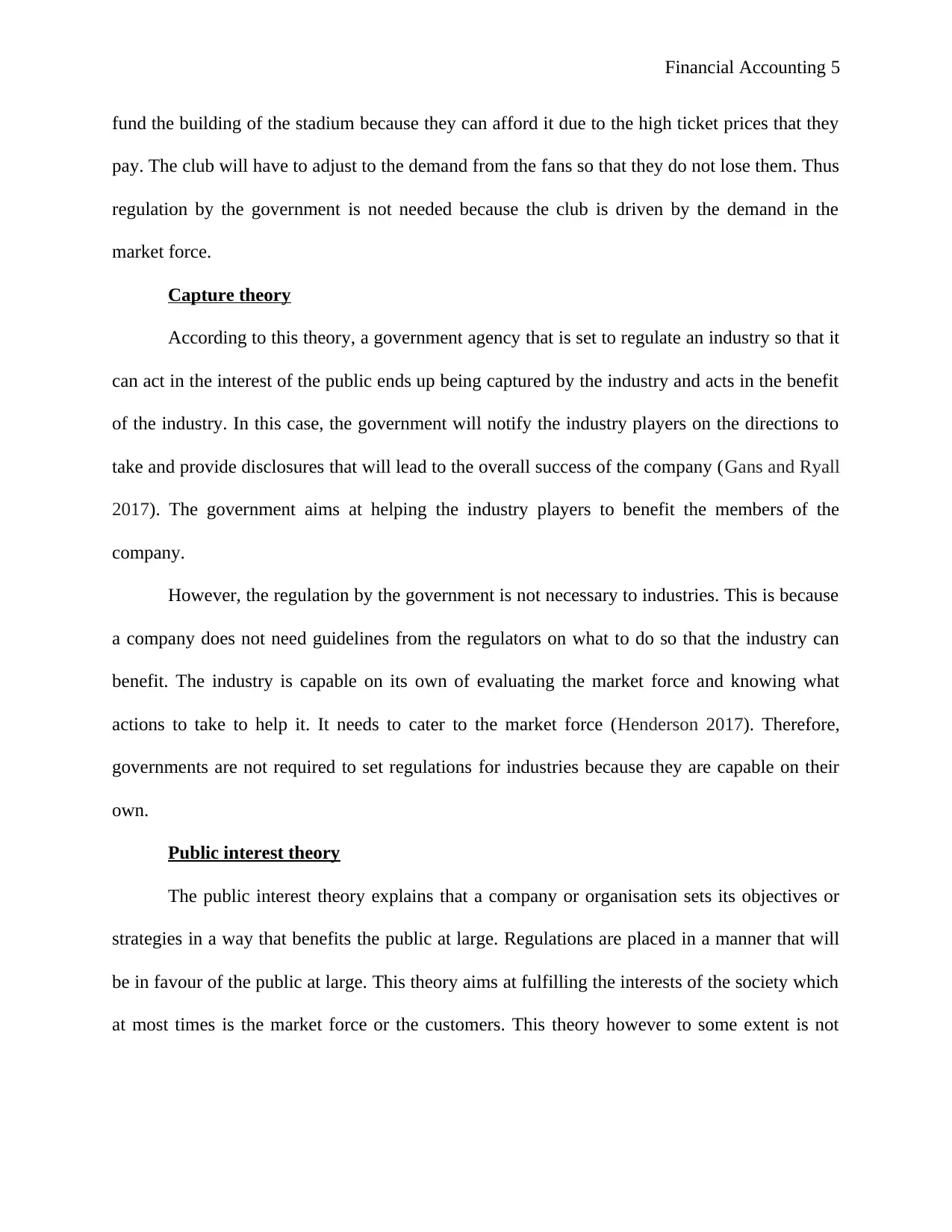
Financial Accounting 5
fund the building of the stadium because they can afford it due to the high ticket prices that they
pay. The club will have to adjust to the demand from the fans so that they do not lose them. Thus
regulation by the government is not needed because the club is driven by the demand in the
market force.
Capture theory
According to this theory, a government agency that is set to regulate an industry so that it
can act in the interest of the public ends up being captured by the industry and acts in the benefit
of the industry. In this case, the government will notify the industry players on the directions to
take and provide disclosures that will lead to the overall success of the company (Gans and Ryall
2017). The government aims at helping the industry players to benefit the members of the
company.
However, the regulation by the government is not necessary to industries. This is because
a company does not need guidelines from the regulators on what to do so that the industry can
benefit. The industry is capable on its own of evaluating the market force and knowing what
actions to take to help it. It needs to cater to the market force (Henderson 2017). Therefore,
governments are not required to set regulations for industries because they are capable on their
own.
Public interest theory
The public interest theory explains that a company or organisation sets its objectives or
strategies in a way that benefits the public at large. Regulations are placed in a manner that will
be in favour of the public at large. This theory aims at fulfilling the interests of the society which
at most times is the market force or the customers. This theory however to some extent is not
fund the building of the stadium because they can afford it due to the high ticket prices that they
pay. The club will have to adjust to the demand from the fans so that they do not lose them. Thus
regulation by the government is not needed because the club is driven by the demand in the
market force.
Capture theory
According to this theory, a government agency that is set to regulate an industry so that it
can act in the interest of the public ends up being captured by the industry and acts in the benefit
of the industry. In this case, the government will notify the industry players on the directions to
take and provide disclosures that will lead to the overall success of the company (Gans and Ryall
2017). The government aims at helping the industry players to benefit the members of the
company.
However, the regulation by the government is not necessary to industries. This is because
a company does not need guidelines from the regulators on what to do so that the industry can
benefit. The industry is capable on its own of evaluating the market force and knowing what
actions to take to help it. It needs to cater to the market force (Henderson 2017). Therefore,
governments are not required to set regulations for industries because they are capable on their
own.
Public interest theory
The public interest theory explains that a company or organisation sets its objectives or
strategies in a way that benefits the public at large. Regulations are placed in a manner that will
be in favour of the public at large. This theory aims at fulfilling the interests of the society which
at most times is the market force or the customers. This theory however to some extent is not
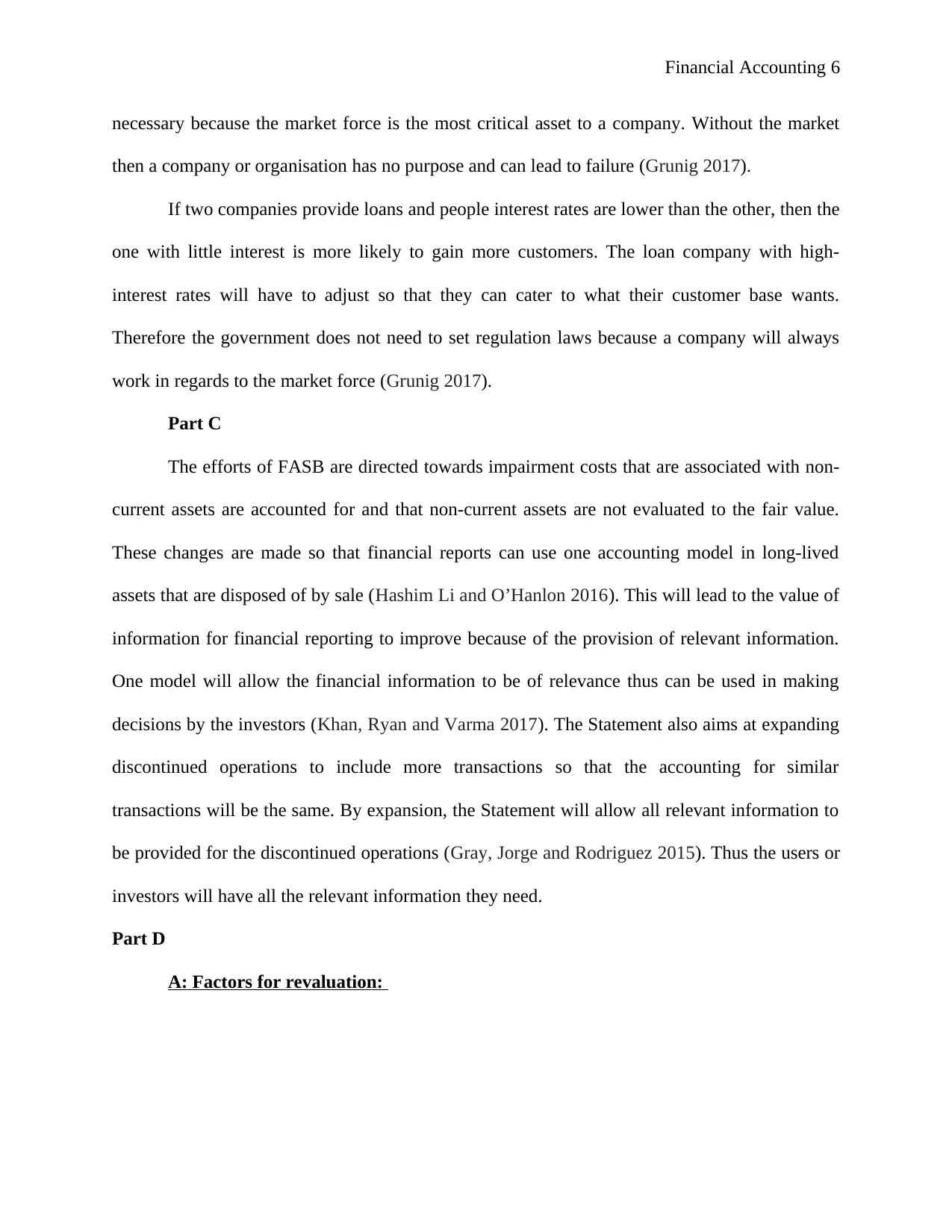
Financial Accounting 6
necessary because the market force is the most critical asset to a company. Without the market
then a company or organisation has no purpose and can lead to failure (Grunig 2017).
If two companies provide loans and people interest rates are lower than the other, then the
one with little interest is more likely to gain more customers. The loan company with high-
interest rates will have to adjust so that they can cater to what their customer base wants.
Therefore the government does not need to set regulation laws because a company will always
work in regards to the market force (Grunig 2017).
Part C
The efforts of FASB are directed towards impairment costs that are associated with non-
current assets are accounted for and that non-current assets are not evaluated to the fair value.
These changes are made so that financial reports can use one accounting model in long-lived
assets that are disposed of by sale (Hashim Li and O’Hanlon 2016). This will lead to the value of
information for financial reporting to improve because of the provision of relevant information.
One model will allow the financial information to be of relevance thus can be used in making
decisions by the investors (Khan, Ryan and Varma 2017). The Statement also aims at expanding
discontinued operations to include more transactions so that the accounting for similar
transactions will be the same. By expansion, the Statement will allow all relevant information to
be provided for the discontinued operations (Gray, Jorge and Rodriguez 2015). Thus the users or
investors will have all the relevant information they need.
Part D
A: Factors for revaluation:
necessary because the market force is the most critical asset to a company. Without the market
then a company or organisation has no purpose and can lead to failure (Grunig 2017).
If two companies provide loans and people interest rates are lower than the other, then the
one with little interest is more likely to gain more customers. The loan company with high-
interest rates will have to adjust so that they can cater to what their customer base wants.
Therefore the government does not need to set regulation laws because a company will always
work in regards to the market force (Grunig 2017).
Part C
The efforts of FASB are directed towards impairment costs that are associated with non-
current assets are accounted for and that non-current assets are not evaluated to the fair value.
These changes are made so that financial reports can use one accounting model in long-lived
assets that are disposed of by sale (Hashim Li and O’Hanlon 2016). This will lead to the value of
information for financial reporting to improve because of the provision of relevant information.
One model will allow the financial information to be of relevance thus can be used in making
decisions by the investors (Khan, Ryan and Varma 2017). The Statement also aims at expanding
discontinued operations to include more transactions so that the accounting for similar
transactions will be the same. By expansion, the Statement will allow all relevant information to
be provided for the discontinued operations (Gray, Jorge and Rodriguez 2015). Thus the users or
investors will have all the relevant information they need.
Part D
A: Factors for revaluation:
⊘ This is a preview!⊘
Do you want full access?
Subscribe today to unlock all pages.

Trusted by 1+ million students worldwide
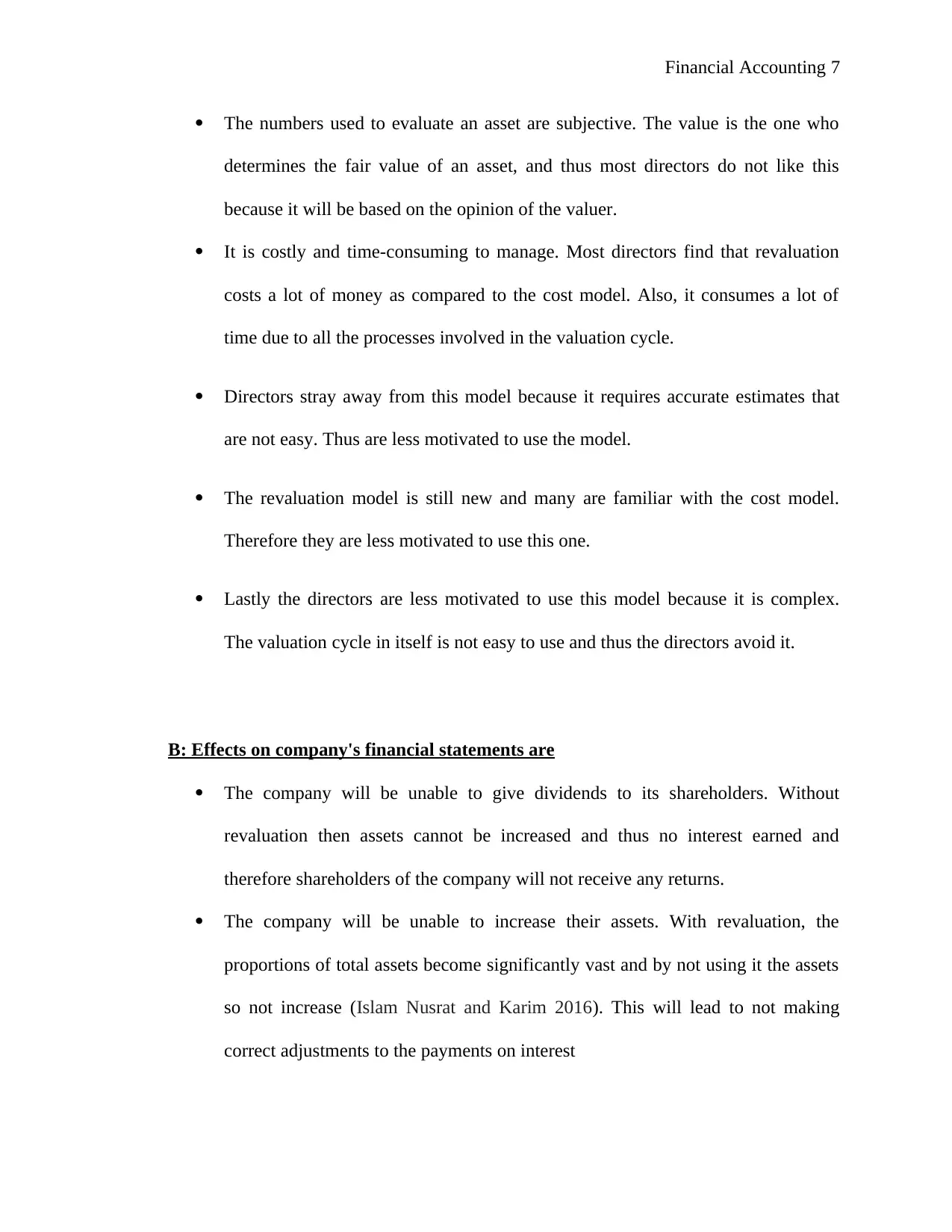
Financial Accounting 7
The numbers used to evaluate an asset are subjective. The value is the one who
determines the fair value of an asset, and thus most directors do not like this
because it will be based on the opinion of the valuer.
It is costly and time-consuming to manage. Most directors find that revaluation
costs a lot of money as compared to the cost model. Also, it consumes a lot of
time due to all the processes involved in the valuation cycle.
Directors stray away from this model because it requires accurate estimates that
are not easy. Thus are less motivated to use the model.
The revaluation model is still new and many are familiar with the cost model.
Therefore they are less motivated to use this one.
Lastly the directors are less motivated to use this model because it is complex.
The valuation cycle in itself is not easy to use and thus the directors avoid it.
B: Effects on company's financial statements are
The company will be unable to give dividends to its shareholders. Without
revaluation then assets cannot be increased and thus no interest earned and
therefore shareholders of the company will not receive any returns.
The company will be unable to increase their assets. With revaluation, the
proportions of total assets become significantly vast and by not using it the assets
so not increase (Islam Nusrat and Karim 2016). This will lead to not making
correct adjustments to the payments on interest
The numbers used to evaluate an asset are subjective. The value is the one who
determines the fair value of an asset, and thus most directors do not like this
because it will be based on the opinion of the valuer.
It is costly and time-consuming to manage. Most directors find that revaluation
costs a lot of money as compared to the cost model. Also, it consumes a lot of
time due to all the processes involved in the valuation cycle.
Directors stray away from this model because it requires accurate estimates that
are not easy. Thus are less motivated to use the model.
The revaluation model is still new and many are familiar with the cost model.
Therefore they are less motivated to use this one.
Lastly the directors are less motivated to use this model because it is complex.
The valuation cycle in itself is not easy to use and thus the directors avoid it.
B: Effects on company's financial statements are
The company will be unable to give dividends to its shareholders. Without
revaluation then assets cannot be increased and thus no interest earned and
therefore shareholders of the company will not receive any returns.
The company will be unable to increase their assets. With revaluation, the
proportions of total assets become significantly vast and by not using it the assets
so not increase (Islam Nusrat and Karim 2016). This will lead to not making
correct adjustments to the payments on interest
Paraphrase This Document
Need a fresh take? Get an instant paraphrase of this document with our AI Paraphraser
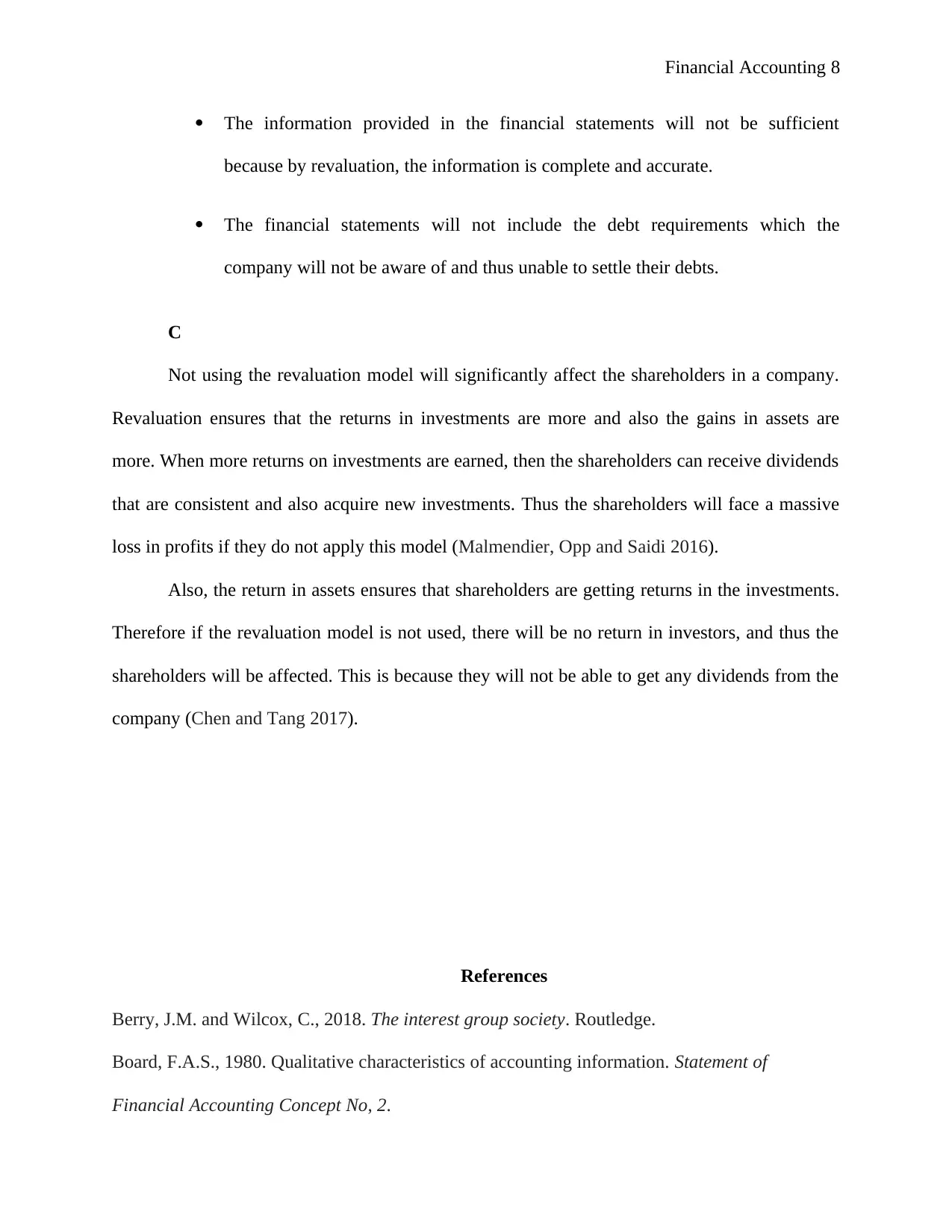
Financial Accounting 8
The information provided in the financial statements will not be sufficient
because by revaluation, the information is complete and accurate.
The financial statements will not include the debt requirements which the
company will not be aware of and thus unable to settle their debts.
C
Not using the revaluation model will significantly affect the shareholders in a company.
Revaluation ensures that the returns in investments are more and also the gains in assets are
more. When more returns on investments are earned, then the shareholders can receive dividends
that are consistent and also acquire new investments. Thus the shareholders will face a massive
loss in profits if they do not apply this model (Malmendier, Opp and Saidi 2016).
Also, the return in assets ensures that shareholders are getting returns in the investments.
Therefore if the revaluation model is not used, there will be no return in investors, and thus the
shareholders will be affected. This is because they will not be able to get any dividends from the
company (Chen and Tang 2017).
References
Berry, J.M. and Wilcox, C., 2018. The interest group society. Routledge.
Board, F.A.S., 1980. Qualitative characteristics of accounting information. Statement of
Financial Accounting Concept No, 2.
The information provided in the financial statements will not be sufficient
because by revaluation, the information is complete and accurate.
The financial statements will not include the debt requirements which the
company will not be aware of and thus unable to settle their debts.
C
Not using the revaluation model will significantly affect the shareholders in a company.
Revaluation ensures that the returns in investments are more and also the gains in assets are
more. When more returns on investments are earned, then the shareholders can receive dividends
that are consistent and also acquire new investments. Thus the shareholders will face a massive
loss in profits if they do not apply this model (Malmendier, Opp and Saidi 2016).
Also, the return in assets ensures that shareholders are getting returns in the investments.
Therefore if the revaluation model is not used, there will be no return in investors, and thus the
shareholders will be affected. This is because they will not be able to get any dividends from the
company (Chen and Tang 2017).
References
Berry, J.M. and Wilcox, C., 2018. The interest group society. Routledge.
Board, F.A.S., 1980. Qualitative characteristics of accounting information. Statement of
Financial Accounting Concept No, 2.
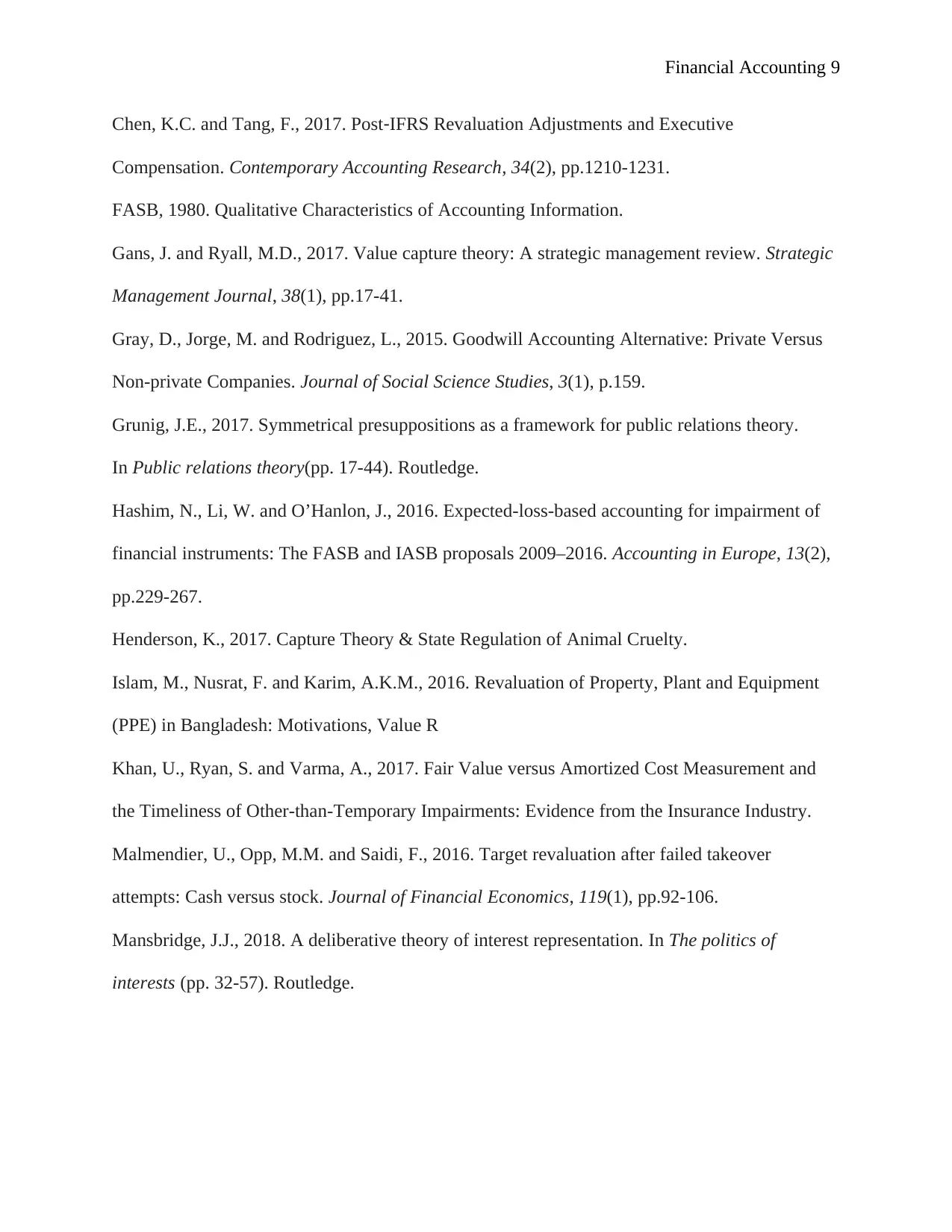
Financial Accounting 9
Chen, K.C. and Tang, F., 2017. Post‐IFRS Revaluation Adjustments and Executive
Compensation. Contemporary Accounting Research, 34(2), pp.1210-1231.
FASB, 1980. Qualitative Characteristics of Accounting Information.
Gans, J. and Ryall, M.D., 2017. Value capture theory: A strategic management review. Strategic
Management Journal, 38(1), pp.17-41.
Gray, D., Jorge, M. and Rodriguez, L., 2015. Goodwill Accounting Alternative: Private Versus
Non-private Companies. Journal of Social Science Studies, 3(1), p.159.
Grunig, J.E., 2017. Symmetrical presuppositions as a framework for public relations theory.
In Public relations theory(pp. 17-44). Routledge.
Hashim, N., Li, W. and O’Hanlon, J., 2016. Expected-loss-based accounting for impairment of
financial instruments: The FASB and IASB proposals 2009–2016. Accounting in Europe, 13(2),
pp.229-267.
Henderson, K., 2017. Capture Theory & State Regulation of Animal Cruelty.
Islam, M., Nusrat, F. and Karim, A.K.M., 2016. Revaluation of Property, Plant and Equipment
(PPE) in Bangladesh: Motivations, Value R
Khan, U., Ryan, S. and Varma, A., 2017. Fair Value versus Amortized Cost Measurement and
the Timeliness of Other-than-Temporary Impairments: Evidence from the Insurance Industry.
Malmendier, U., Opp, M.M. and Saidi, F., 2016. Target revaluation after failed takeover
attempts: Cash versus stock. Journal of Financial Economics, 119(1), pp.92-106.
Mansbridge, J.J., 2018. A deliberative theory of interest representation. In The politics of
interests (pp. 32-57). Routledge.
Chen, K.C. and Tang, F., 2017. Post‐IFRS Revaluation Adjustments and Executive
Compensation. Contemporary Accounting Research, 34(2), pp.1210-1231.
FASB, 1980. Qualitative Characteristics of Accounting Information.
Gans, J. and Ryall, M.D., 2017. Value capture theory: A strategic management review. Strategic
Management Journal, 38(1), pp.17-41.
Gray, D., Jorge, M. and Rodriguez, L., 2015. Goodwill Accounting Alternative: Private Versus
Non-private Companies. Journal of Social Science Studies, 3(1), p.159.
Grunig, J.E., 2017. Symmetrical presuppositions as a framework for public relations theory.
In Public relations theory(pp. 17-44). Routledge.
Hashim, N., Li, W. and O’Hanlon, J., 2016. Expected-loss-based accounting for impairment of
financial instruments: The FASB and IASB proposals 2009–2016. Accounting in Europe, 13(2),
pp.229-267.
Henderson, K., 2017. Capture Theory & State Regulation of Animal Cruelty.
Islam, M., Nusrat, F. and Karim, A.K.M., 2016. Revaluation of Property, Plant and Equipment
(PPE) in Bangladesh: Motivations, Value R
Khan, U., Ryan, S. and Varma, A., 2017. Fair Value versus Amortized Cost Measurement and
the Timeliness of Other-than-Temporary Impairments: Evidence from the Insurance Industry.
Malmendier, U., Opp, M.M. and Saidi, F., 2016. Target revaluation after failed takeover
attempts: Cash versus stock. Journal of Financial Economics, 119(1), pp.92-106.
Mansbridge, J.J., 2018. A deliberative theory of interest representation. In The politics of
interests (pp. 32-57). Routledge.
⊘ This is a preview!⊘
Do you want full access?
Subscribe today to unlock all pages.

Trusted by 1+ million students worldwide
1 out of 9
Related Documents
Your All-in-One AI-Powered Toolkit for Academic Success.
+13062052269
info@desklib.com
Available 24*7 on WhatsApp / Email
![[object Object]](/_next/static/media/star-bottom.7253800d.svg)
Unlock your academic potential
Copyright © 2020–2025 A2Z Services. All Rights Reserved. Developed and managed by ZUCOL.




